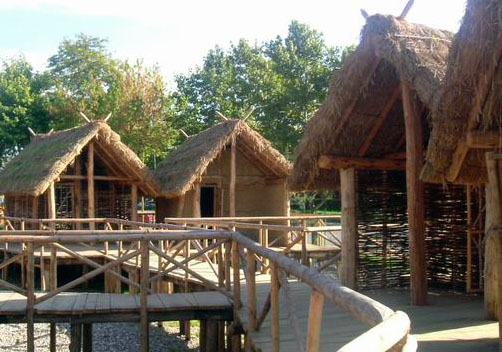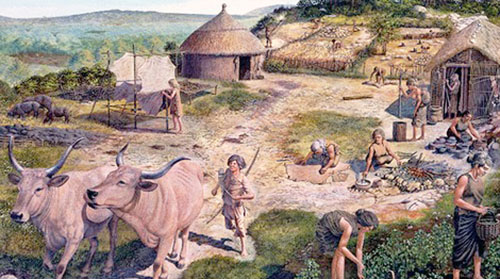Neolithic people, thanks to the mental strength, inventiveness and skill gradually adopted a new ways of economy, primarily in farming and livestock breeding, and in a way, they fundamentally changed their lives.
A considerable increase of the population and efforts of agricultural people to live in areas where there were no natural shelters required from them to built large number of objects for living.
Neolithic dwellings
At the beginning, these objects for living were dugout shelters covered with branches, earth, stone or animal skin. After that came pile dwellings, which were built individually, or as entire villages in shallow coastal or hill parts of lakes, swamps and rivers. They built it also for the protection of wildlife and hostile tribes. At the end, all of this led to today’s residential buildings – houses and buildings for housing.
First Neolithic dwellings were built of materials that were found around the place of construction. Materials used for building was mostly rocks, large logs, branches, raw brick, reeds, mud, turf of earth, etc.
A particularly important nature factor, which greatly has influenced on the location and the way of constructing objects for living, was climatic conditions. While in the warmer regions, poorly built dwellings could quite satisfy people who live in it and the climate of that region. In many parts of the European and Asian continents, people built much more solid dwellings, which were well protected from wind and rain. In the areas where there is cold and windy climate, Neolithic people, over time, came to an idea to build floors of their dwellings below ground level and to protect an entry into to the room with one smaller hall.



Construction of residential settlements with mud or dried brick was not an option in regions where there was lot of rain and where there was not enough sun to dry it and make it solid again. The oldest farming houses were discovered in Palestine, on the site of Jericho, Iraq and in the village Jarmo. The first pile dwellings were found on the shallow bottom of the lake Zurich in Switzerland, then in Italy, Germany, England, Ireland, Sweden, Russia, and so on.
Neolithic economy
Generally, Neolithic agriculture was based on a mixed economy. About agriculture most convincingly spoke oldest villages in which the livestock and growing of crops were present with clear tendency for a further economic progress, and therefore the overall development of society.
The traditions of the New Stone Age are different according to a degree and direction of economic development. Neolithic people made local cultural – historical communities. Collecting of plant products, then hunting and fishing which were still perfected, became more organized ways of economy. In some regions, noticeable improvement of fishing affected that hunting becomes suppressed and vice versa. Collecting of wild grains has resulted with introduction of primitive farming, and along with it also livestock.
Livestock breeding has developed from hunting. Neolithic people, and before them Mesolithic people, began to domesticate and breed those animals that up until then, during many decades were organizationally killed. In the beginning, people have bred animals primarily for meat, i.e. just for food, but later they began to use their hair, fur, wool and milk, and some of those animals were used for towing. The very process of animal domestication affected an entire earthly place, but not at the same time and not under the same conditions. Domestication of animals was very long, and very hard. Domesticated animals were breed by force and they gave new animal species.
Farming and life in the permanently inhabited place can be accepted as the first feature of a complete Neolithic era revolution. Introduction of agriculture is closely related to the collecting economy that in the late Mesolithic and at the beginning of Neolithic period was at the highest peak. However, during collection of plant products Neolithic people have noticed that by planting or seeding those plants in the grounded earth, they can breed various edible plants and grains. It is assumed that the cradle of agriculture is southwest Asia. The earliest farming was very limited. People worked on smaller plots of land by growing in them one or two different cultures. Tools for work were extremely primitive.
Farming first appeared in those regions that were most suitable for this activity. Those were valleys of large rivers such as the Euphrates, Tigris, Nile, Indus, Yellow River and others. Later, it came to the development of agriculture in forest regions, in areas where forests protected land and crops from various weather conditions. Neolithic people have been cutting bushes and small vegetation with a stone axe, and then they would burn it all, so that they have ashes, which they used for fertilizing the soil. After they would exhaust the fertility of some land, they would leave it so that they could found another fertile land.
People began to put fences around the plots where they planted plants so that they keep them away from wild beasts. New agriculture sector had different character unlike the previous, which were oriented towards the collection of everything that could be found in nature.
The first tool that Neolithic people used for farming was a hoe-digger, whose one end was sharp. Hoe-digger was firstly used during collecting of plant fruits and digging out various roots. Later, they made poles with flat ball-shaped ends, and then hoes, which have large use in agricultural production. The first hoe was an ordinary branch with shorter branch in its working area. After that people started, instead of branch to put on the pole tightly attached sharp stone or bone spike.



At the beginning of the New Stone Age, man was growing only those plants that grow in the area of his residence. Planting crops and farming of edible plants spread rapidly, thanks to the fact that it was easier to accept than to make any changes in the development of tools.
Indochina is considered to be a homeland of rice; barley – southwest Asia; wheat – Asia, Europe and northern part of Africa; millet – Switzerland; corn, potatoes, tobacco, sunflower and pumpkin – America; cabbage – the European continent; tea – China and India; coffee – Ethiopia; cocoa – Central America; rye – the southern part of the Caucasus and the Caspian Sea coast, etc. Homeland of millet and oats is not yet precisely determined, although certain remains of millet were found in Swiss pile dwellings. Among the earliest crops are millet, rice, barley and wheat while rye and oat cereals appeared much later. New branches of economy, agriculture and livestock, represented a great victory of Neolithic people in the struggle with nature. Thanks to them, people have come into a new situation in which they could provided for themselves a diverse and regular diet, creating, at the same time, and food stocks in meat, grain, vegetable fruits and so on.
At the same time, it was the reason to stay much longer in the same area. However, the majority of Neolithic people growing of crops, plants and animals were a minor, less known occupation, while hunting, fishing and collecting of fruits was still in the first place. All members of the gender managed an economy of the tribe in the early Neolithic. Later, this right had only certain selected members of tribal communities. Oldest women of the tribe managed household.
During the Neolithic period almost exclusively was represented so-called natural division of labor, mainly by gender. Later on, a division was done based on the age of a person. While men went hunting for wild animals, or fishing or they dealt with the domestication of animals and the development of tools and weapons, women – mothers were engaged in collecting plant products, also they cultivated the land and also they were involved in home activities such as cooking, childcare, care of the elderly, weaving, making clothes, and so on.
With the introduction of agriculture, neolithic men more and more turn to clearing the forests, neglecting, at the same time, hunting and fishing. However, in this way, people created new arable land for which eventually they became were attached. With this act, man has stooped being a nomad and he moved to a sedentary lifestyle. At the same time, women and children were making ground more suitable for sowing and planting certain plants. Cleared land was divided between the tribes, and home communities, while ownership over the land had the tribe.
Agriculture and livestock breeding thanks to the constant advancing affected on the development of new and further expansions of existing settlements, and thus it spread on to populated territories.
For New Stone Age, it is related phenomenon of primitive spinning, knitting and weaving, and among the most common knitting products were various cloths, numerous ropes, nets, bags, long belts, footwear, hats, various dishes, etc. Materials for knitting consisted of various “wattle, bark, skin, hair, wood fiber, hair, etc.
